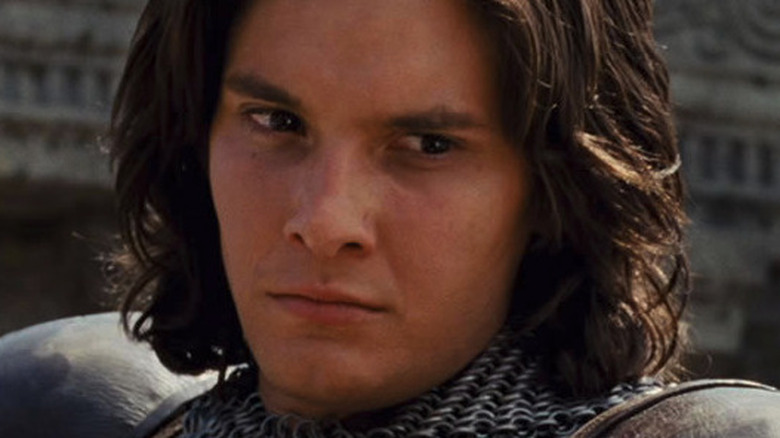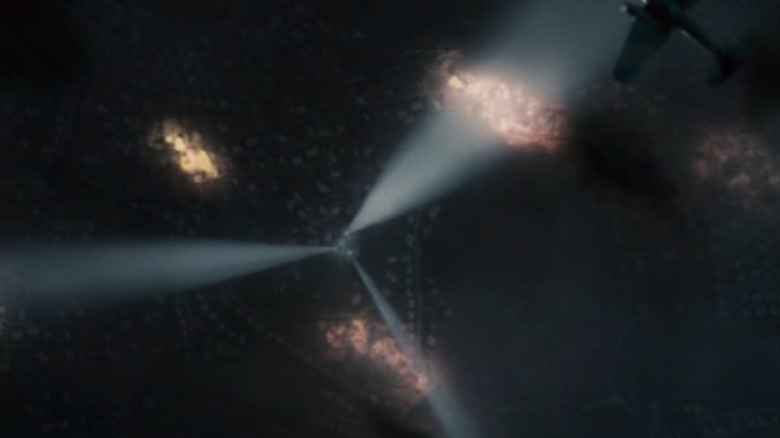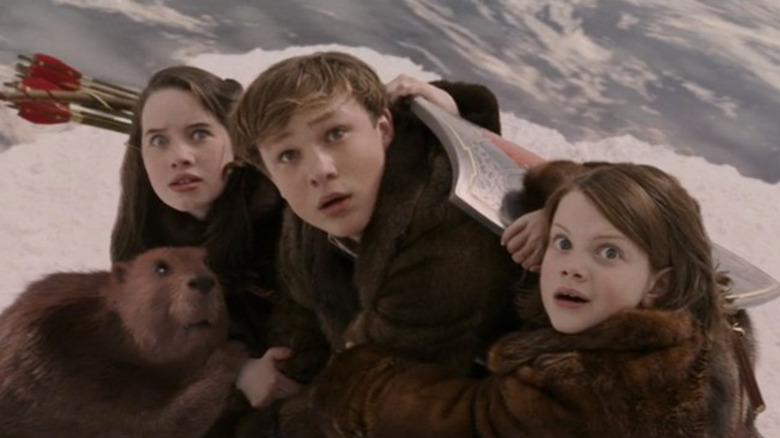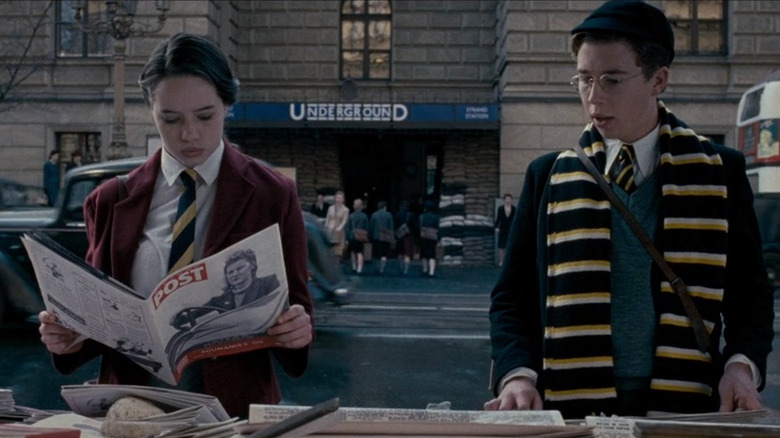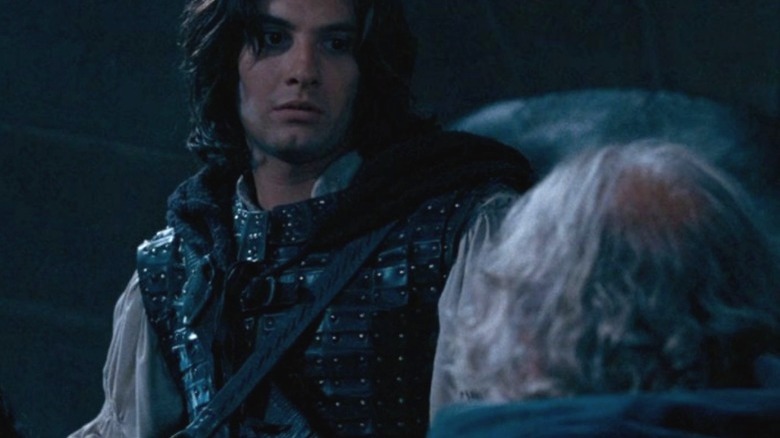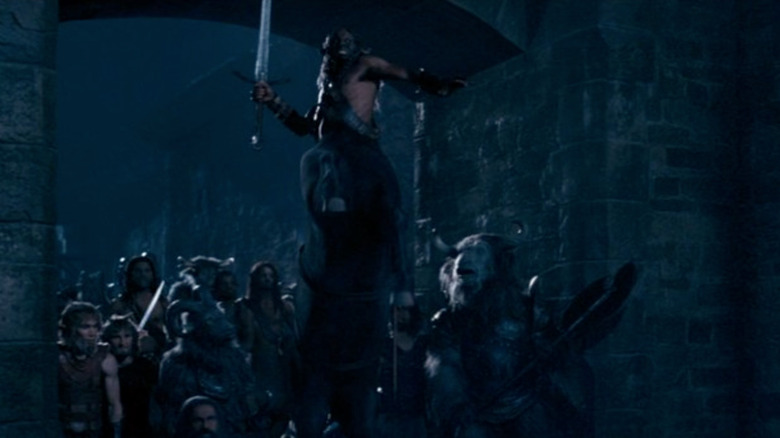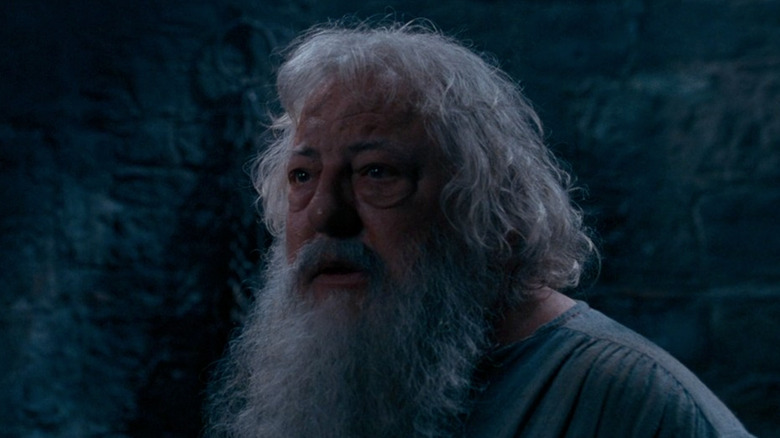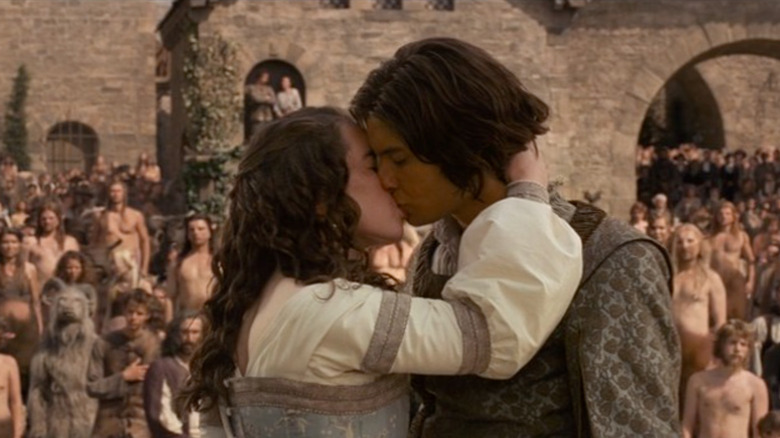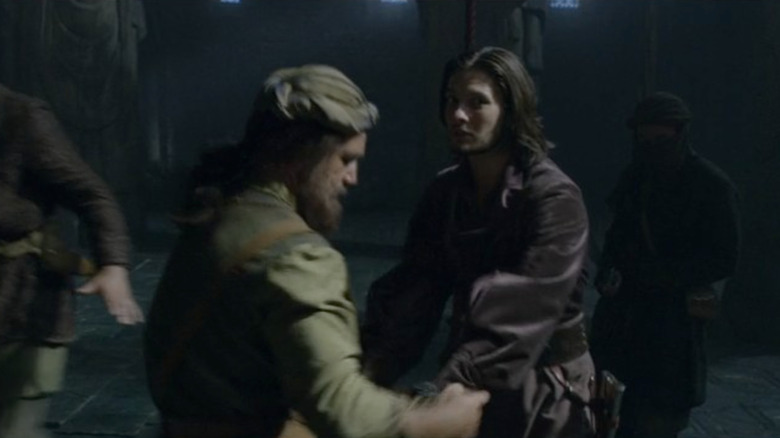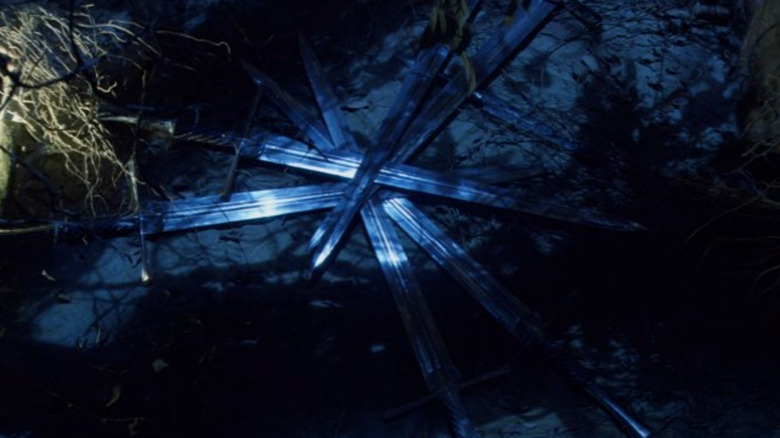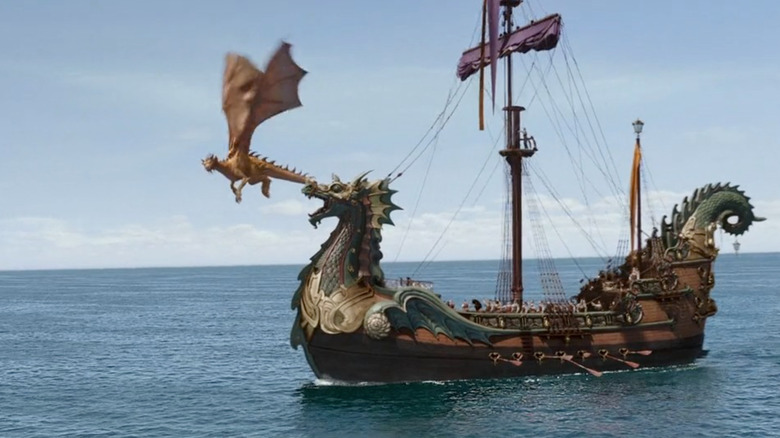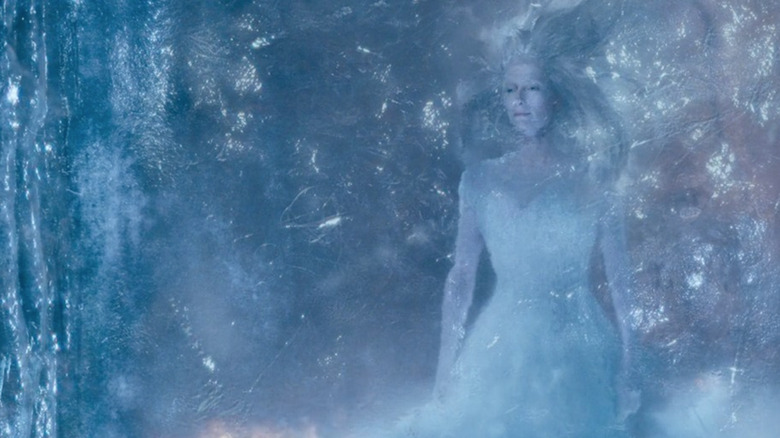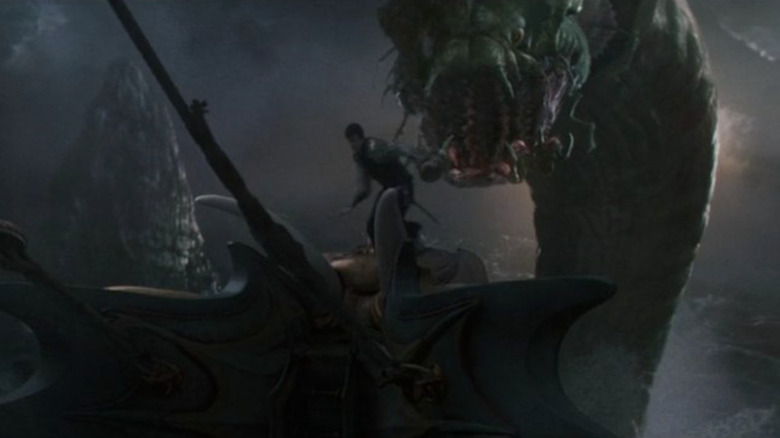Things The Chronicles Of Narnia Franchise Gets Wrong About The Novel Series
First published in the 1950s, "The Chronicles of Narnia" is a classic fantasy series that has captivated multiple generations of readers. C.S. Lewis's beloved books brillaintly combine ancient mythology with a sense of childlike wonder. Unlike the works of his good friend J.R.R. Tolkien, the author's Narnia stories remain kid-focused and family-friendly throughout, with all seven book sticking to this formula.
In the early '00s, The House of Mouse scooped up the film rights and produced a pair of Narnia films, starting with "The Lion, the Witch, and the Wardrobe" in 2005. The first sequel, "Prince Caspian," arrived in 2008, and then Fox released the third story in the saga, "The Voyage of the Dawn Treader," in late 2010. After that, production stalled and the series petered out. Much of the story went untold, but the three films that did see the light of day went down well with fans. The trilogy collectively grossed over $1.5 billion at the box office, and the Narnia films have remained childhood staples ever since.
Just because they're fan favorites, though, doesn't mean they're accurate. While they embody the spirit of Lewis's world in many ways, the adaptations frequently stray from the source material. We've gone through the movies and highlighted a handful of the most glaring changes, from made-up action sequences to randomly inserted romantic inklings and everything in between.
The bombing of London isn't in the book
Right from the get-go, there are some hefty changes between the book and movie versions of Lewis's narrative. "The Lion, the Witch, and the Wardrobe" film opens with a harrowing scene in London during World War II. German bombers are flying overhead, and there are explosions everywhere. Edmund nearly gets Peter and himself killed trying to recover a picture of his father before the two boys join their sisters and mother in the nearby bomb shelter. We see some early tension between the boys, and then, all of a sudden, the Pevensie siblings are out in the countryside, heading to Professor Digory Kirke's house.
Believe it or not, this quick start to set the stage is even faster in the book. Lewis begins with the kids already out of London and forges ahead from there. However, the opening scene of the movie isn't exactly pulled out of thin air. In the second sentence of the book, the author summarizes the motivation for their trip to the professor's house by saying, "This story is about something that happened to [the four Pevensie children] when they were sent away from London during the war because of the air-raids."
That's it. No dramatic scene. No glimpse into the motivation for Edmund's sour attitude. No initial drama between the brothers. Just a quick note that there were air-raids, and the kids had to get the heck out of dodge.
The movies are overloaded with action
The most difficult thing about adapting a novel for the screen is pacing. Books can spend dozens of pages describing a scene or going into great detail about someone's inner thoughts and emotions, all of which flash by in an instant during a movie. On the flip side, an action sequence can be briefly mentioned in text, with the same event taking up dozens of minutes of screen time — or, in the case of "The Hobbit: The Battle of Five Armies," a whole freaking movie.
The Narnia films fall victim to this action overload early and often. Take the scene where the wolves arrive at Beaver's Dam. There's a scramble followed by an underground escape. Our heroes flee, and the narrator even points out that it's a good thing the falling snow covered their tracks or they probably wouldn't have gotten far. A little later, the wolves catch up to them at a frozen waterfall, which is followed by an epic action scene — none of which is in the book.
Even the Battle of Beruna at the end of the first movie is beefed up. In the book, Susan, Lucy, and the resurrected Aslan arrive on the battlefield late, witnessing the end of the fight. There are none of the long, drawn-out battle sequences that we get in the film version. And we're still just talking about the first film. The same issue plagues the other two, as well.
The start of the second film is drastically different
Like "The Lion, the Witch, and the Wardrobe," follow-up film "Prince Caspian" jumps straight into the story. In the book, we open up on the four kids at a train station heading to boarding school. They're all gloomy with school starting and all, but nothing particularly exciting is going on. In fact, it explicitly states that "It was an empty, sleepy, country station and there was hardly anyone on the platform except themselves."
In the opening scene of the "Prince Caspian" movie, there's a very different feel. First off, the story starts in Narnia, which is a big change (more on that later). When we get to the Pevensie siblings, we find them in a bustling city center. Susan is fending off a romantically-inclined schoolboy. Peter is picking fights. People are everywhere. The two openings are dramatically different, but it isn't surprising that the writers opted for action-heavy, romance-laced dramatics over a quiet country scene.
Still, the bustling background does beg the question of how nobody notices when the kiddos are suddenly whisked away to Narnia a few moments later. It seems like something that would be more discreet in an out-of-the-way country train station. But this is deep magic we're talking about, after all, so there's no end to the number of explanations for that one.
Prince Caspian's escape doesn't happen in real-time
The first thing we see in the "Prince Caspian" film is a sequence in which the evil King Miraz's wife, Queen Prunaprismia (talk about a name), gives birth to a son. This forces their nephew, Caspian, to flee for his life before his wicked uncle kills him to clear the way for his newborn son to become heir to the throne. Caspian rides into the woods, where he meets the fantastical creatures who used to populate the entire country and are collectively referred to as the old Narnians. Caspian (who was almost played by Andrew Garfield) becomes their leader, the Pevensie quartet is recalled to their ancient kingdom, and the rest of the story kicks off from there.
This isn't how the story flows in the books at all. Instead, we jump right in with the Pevensies, who arrive in Narnia and meet one of Caspian's followers, Trumpkin the Dwarf. As the children and Trumpkin piece everything together, the loyal dwarf fills them in on the background of how things have gotten so bad for Caspian and his ragtag group of followers. He reveals that Caspian's aunt had a baby boy and how the prince had to run for his life. So, if you're reading the story, you never see Caspian escape in real-time. Instead, the events get recounted — albeit in plenty of detail — several chapters in as a historical incident that has already happened.
The surprise attack on Miraz's castle never happened
In the film version of "Prince Caspian," Peter gets it into his head that, as Miraz's army approaches, the best thing the old Narnians can do is conduct a surprise raid on his castle. Others resist his plan, but ultimately the High King takes command, and they attack the fortress. The attack starts well, but the tide gets turned and our heroes have to retreat with heavy losses. The whole assault on the castle is abandoned as a failed chapter in the war.
This all makes sense — except for the part where the Narnians never actually attack Miraz in the first place. In the book, there aren't any offensively-minded side adventures or mythological creatures conducting air-raids. All of this is added to spice up the cinematic story. Remember the whole thing about how they add way too much extra action into the movies? Yeah.
Also, Peter's attitude throughout the event is way off. The oldest Pevensie is way too headstrong and clearly feeling out of place as the once-king, returned-king at odds with the new king, Caspian. In the book, there's not much of a power struggle dynamic between the two leaders. Peter recognizes his Aslan-assigned role of helping Caspian come into his own and does what he can without stepping all over his partner's fledgling authority.
Doctor Cornelius isn't rescued by Caspian
Doctor Cornelius is a loyal Narnian who helps prepare Caspian for his future as the King of Narnia. He also saves Caspian's life by helping him escape when his cousin is born. When it gets out that the half-dwarf, half-human doctor helped Caspian flee, he ends up in prison. During the raid on Miraz's castle, Caspian makes sure to free his old mentor and bring him back with him. At least, that's what happens in the movie.
Of course, there isn't a raid on Miraz's castle in the books, so Caspian never rescued Cornelius. Instead, shortly after Caspian joins the Narnians, they're interrupted during an important meeting by none other than Cornelius. He stumbles onto the scene as an unexpected and pleasant surprise for his former pupil. When Caspian asks how Cornelius escaped, the answer isn't a thrilling prison break or riding a horse through a hail of arrows. All the old doctor says is "By a little use of simple magic, your Majesty." It may not be as dramatic as a late-night rescue, but it's still a fun answer in its own way.
Susan and Caspian never fall in love
The first time we see Susan in the "Prince Caspian" movie, she's dealing with a dorky kid who is quite obviously attracted to her. This small scene sets the tone for her arc as a maturing young lady. The connection between Susan and Caspian grows over the course of the movie until it ends with Susan giving Caspian a kiss in the last moments of her time in Narnia. They hug, and she gives him a quick glance and a smile.
Cute, right? Romantic. Heartwarming. Even a bit tragic, considering the fact that right afterward, she steps back into her own world and never sees him again. But then you go and read the book, and there's nothing at all about the two characters having any kind of mutual attraction. That's hardly surprisining when you consider that both Caspian and Susan are a little young for this kind of thing at this point in the book timeline.
Lewis isn't specific when it comes to ages, and we can't find definitive numbers in the text, but readers have used dates, hints, and certain lines to put Caspian and Susan at around 13 years old in the second book — much younger than the actors who portrayed the lovebirds in the second movie. Apparently, the need to shoehorn a mature love story into Lewis's kid-friendly, family-focused story was a priority for the filmmakers.
Caspian is actually sold as a slave
In 2010's "The Voyage of the Dawn Treader," when Caspian and his crew reach the Lone Islands, they are ambushed by slavers and thrown in prison. It's here that Caspian meets Lord Bern, a Telmarine who was once loyal to Caspian's late father. Before long, Caspian, Bern, and their companions get saved by the crew of the Dawn Treader. They reestablish order, set Bern up as the new leader of the area, and head on their merry way.
In the book, though, things get a lot worse before they change direction and end in a similarly positive place. When our heroes are captured, Lord Bern actually buys Caspian as his slave. While this seems terrible at first, it turns out that he did so because the lad reminded him of his old king, Caspian's dad. When Caspian reveals that he is his father's son and the King of Narnia, Bern is overjoyed, and the two hatch a plot to take down the slavers.
In both versions, the crew of the Dawn Treader, with Caspian at their head, storm into the Lone Island's capital city of Narrowhaven and upset the daily slave-trading business. They put the pirating factions in their place, and the righteous Bern takes control. But you can't get around the fact that Caspian gets sold into slavery in the book, which (quite understandably) doesn't take place on screen.
The seven swords is a fluff storyline
As Caspian and his crew are leaving the Lone Islands, Lord Bern randomly approaches him with a crusty old sword in hand. He drops some exposition about how he and his six companions received swords from Caspian's father. Throughout the third movie, these swords become very important. They pop up at different stages and are united to get rid of the sentient, greenish fog stuff threatening the land. What viewers might not know is that the entire "seven swords" storyline was an invention for the movie. It feels out of place, forced into the existing narrative, and ultimately takes away from the better parts of the story.
Don't get us wrong — swords are a big deal in Narnia. The sword that Aslan gives Peter in "The Lion, the Witch, and the Wardrobe" is kept as a sacred object for centuries, for example. However, 2010's "The Voyage of the Dawn Treader" doesn't just invent additional magical swords, it turns them into glowing artifacts that direct the fate of the entire world. It's an odd adjustment that's wholly unnecessary and has literally zero inspiration from the book of the same name beyond the fact that, you know, swords get used in it. That's about it.
Eustace doesn't stay a dragon for so long
Perhaps the most fun part of "The Voyage of the Dawn Treader" is Eustace getting turned into a dragon. The somewhat irritating character is transformed by the experience, turning into one of the best heroes of the entire Narnia canon. But the way dragon-Eustace's story plays out is drastically different in the movie version. In the film, Eustace becomes a dragon and then proceeds to function in that capacity for a long time. He pulls the ship while flying (don't overthink the physics) and even helps fight the serpent at the end of the movie before he's finally turned back into a real boy.
In the book, the entire Eustace storyline is confined to just two chapters, and it never leaves the island where the transformation takes place. Lewis clearly communicates that it would be insane for a tiny ship to sail across the open ocean with a monstrous creature aboard. They even discuss all the issues involved, from seeing if he could fit on the deck to wondering how they could feed him during the voyage.
Eventually, Aslan shows up and restores Eustace to his original form, taming his inner pride and introducing a refreshing sense of humility to the character. While it doesn't last as long as it does in the movie and isn't as impactful, the book version of the adventure makes a lot more sense.
The White Witch is overly involved
The White Witch is the primary villain of both the film and book versions of "The Lion, the Witch, and the Wardrobe." She's in the name, for goodness sake. But after that, her importance in the written text quickly dwindles. In the "Prince Caspian" book, the White Witch is brought up as a possible alternative ally to the then-absent Aslan, but the idea is quickly squelched before any physical manifestation of the old arch-nemesis of Narnia can be conjured. She isn't really discussed in any meaningful way in "The Voyage of the Dawn Treader."
However, the writers of the movie sequels seem to have been incapable of separating themselves from Tilda Swinton's admittedly impressive performance in the first film. She is almost brought back to the real world through black magic in "Prince Caspian" and appears as a very recognizable visual in the green mist during the following movie. While we like the White Witch character as much as the next Narnia fan, continually finding ways to weave her into all three stories is definitely a deviation from Lewis's original vision.
The entire ending of Dawn Treader is very different
The most dramatic change of all happens at the end of the third movie. The big screen version of "The Voyage of the Dawn Treader" closes on an epic encounter with a sea serpent in the devilish green mist that has been hinted at throughout the entire story. This leads to a long, drawn-out battle that is completely unlike the book.
Now, just to be clear, both the sea serpent and the mist are in the book, but they aren't climactic. In fact, they're fairly quick portions of the story. At one point, the crew of the Dawn Treader runs into a very dumb sea serpent that they outsmart and leave behind. At another point, they come across an upper-case D "Darkness" surrounding a little island. When they enter it, they discover one of the seven lords that they're searching for stranded on the little landmass. However, they also find that the Darkness surrounding them manifests as their most terrifying dreams. They quickly escape with some help from a winged Aslan and leave the Dark Island behind.
That's it. No green mist. No massive showdown with a sea monster. In fact, the book lacks a definitive climax, since it's composed of a series of running, disconnected exploratory adventures. The producers of the movie clearly wanted a more complete story with a solid third act, but the way it came together led to the biggest deviation from the source material of them all.
